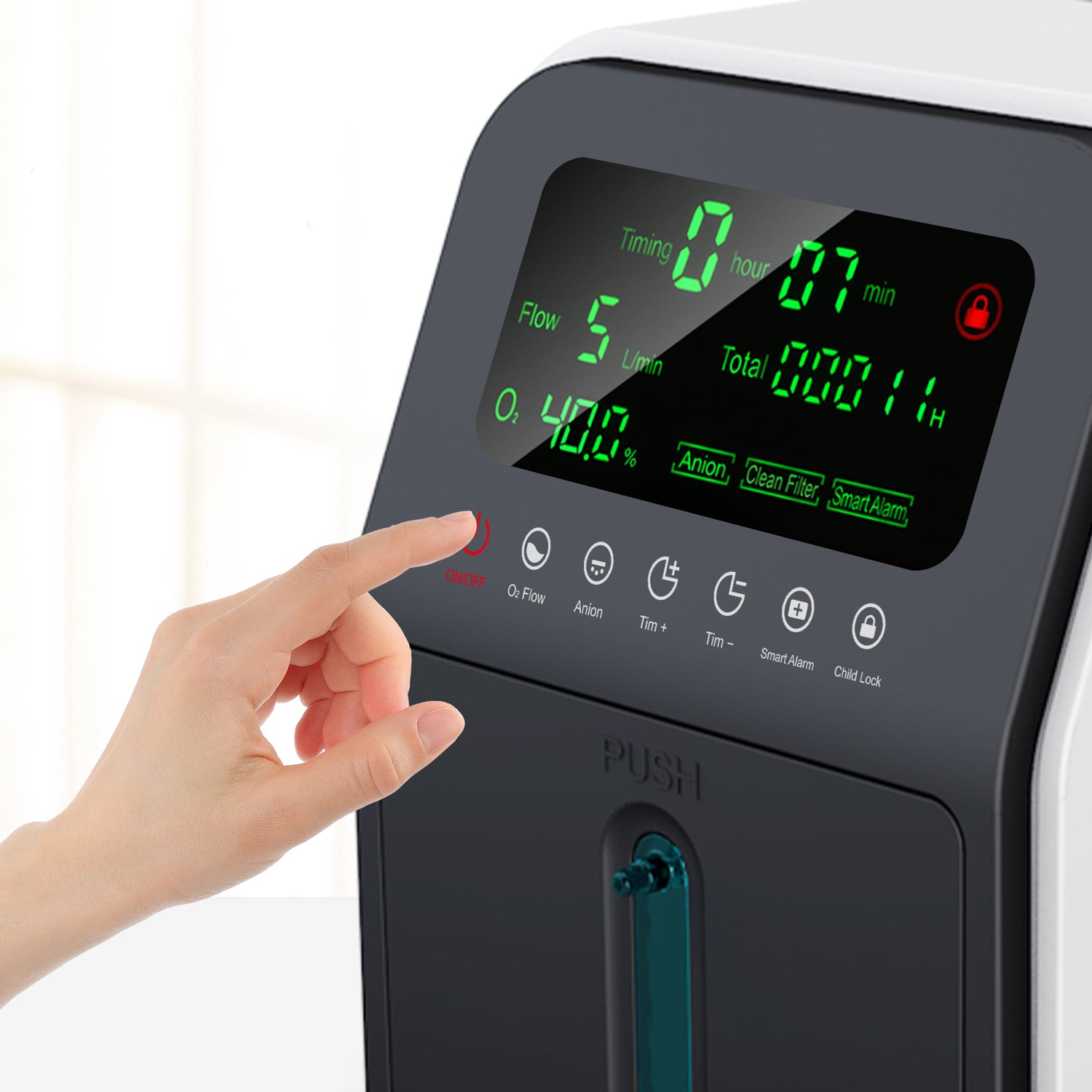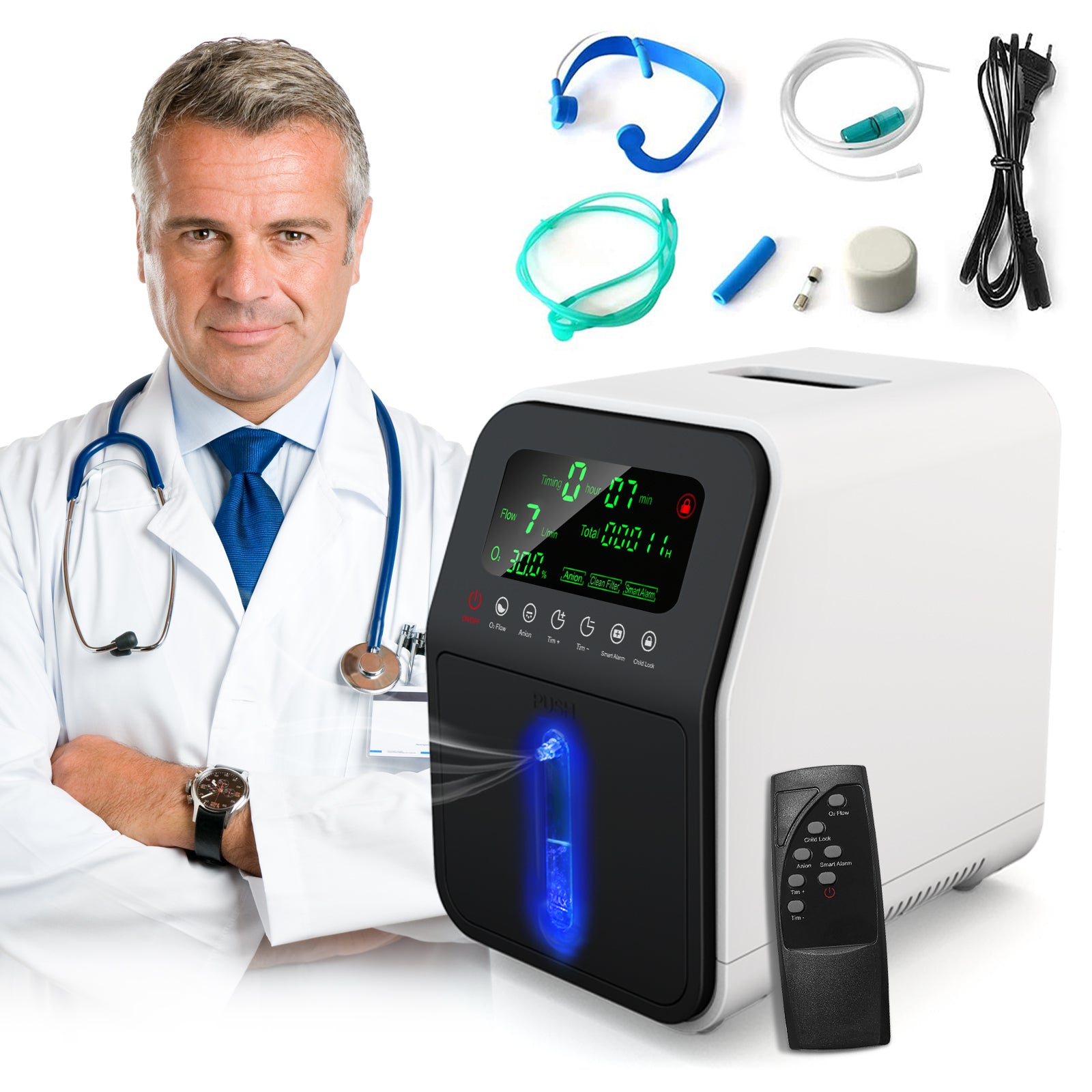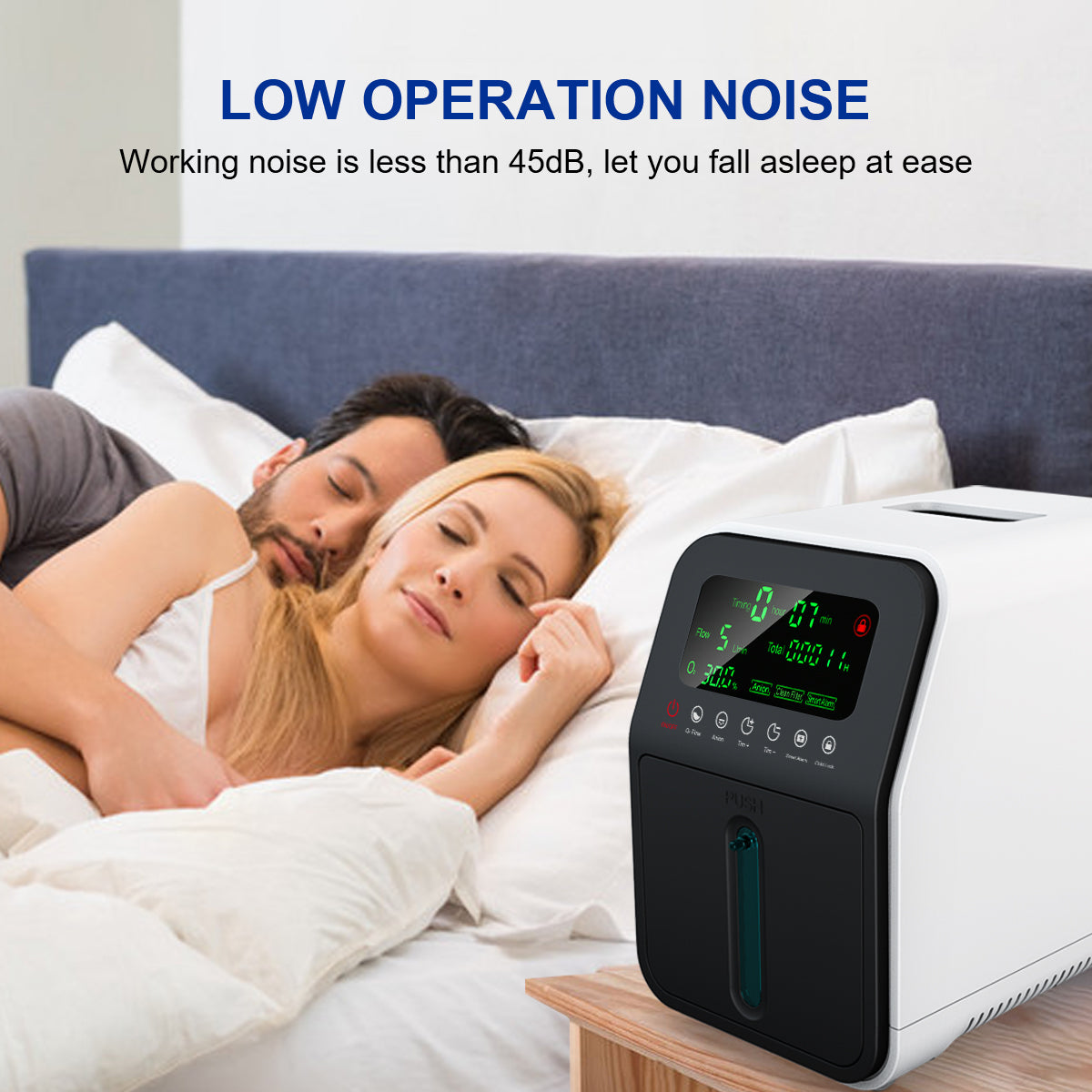Home oxygen concentrators (HOCs) are indispensable medical devices for individuals suffering from conditions that require consistent oxygen supplementation. With growing awareness of respiratory illnesses such as Chronic Obstructive Pulmonary Disease (COPD), asthma, pulmonary fibrosis, and sleep apnea, more people are turning to HOCs for long-term oxygen therapy. This article will explore the many advantages of using a home oxygen concentrator, how it functions, the types available, and critical factors to consider when choosing the right unit for your needs.
---
#### **1. Improved Breathing and Oxygen Levels**
One of the most immediate and significant benefits of a home oxygen concentrator is the improvement in oxygen saturation levels. For individuals suffering from low blood oxygen (hypoxemia), supplemental oxygen therapy improves their oxygen intake, which, in turn, increases the efficiency of bodily functions. Oxygen concentrators pull in ambient air, filter out nitrogen, and deliver concentrated oxygen directly to the patient via a nasal cannula or mask.
Oxygen therapy helps in:
- Easing shortness of breath
- Reducing the strain on the heart by improving oxygen delivery
- Allowing individuals to perform daily activities with less effort
By providing a consistent oxygen supply, the concentrator ensures that users can breathe easier without the risk of oxygen depletion.
---
#### **2. Continuous and Reliable Oxygen Flow**
Unlike portable oxygen concentrators (POCs) designed for mobility, home oxygen concentrators are built to provide **continuous flow oxygen** for longer durations. Continuous flow refers to a constant stream of oxygen, which is critical for people with severe respiratory conditions who need a steady supply throughout the day and night. These machines can be set to deliver a specific liter-per-minute (LPM) oxygen flow rate, ranging from 1 to 5 liters, and in some advanced models, even higher.
For individuals requiring **high-flow oxygen therapy**, which is common among severe COPD patients, home models are better suited. The concentrator works non-stop, delivering a stable oxygen output that can be customized according to the patient's prescription.
---
#### **3. Quiet Operation for Home Use**
Many patients worry about the noise levels of medical devices, especially those that need to operate around the clock. Luckily, modern home oxygen concentrators are designed with **noise reduction technology** that makes them quiet enough for home environments, even during sleep.
Some models, like the Philips EverFlo, operate at a noise level as low as 40 decibels—quieter than a normal conversation—making it suitable for bedrooms or living areas without causing disruptions. This is crucial for patients who rely on uninterrupted oxygen therapy during sleep, as the concentrator ensures a peaceful environment while delivering a constant oxygen supply.
---
#### **4. No Need for Oxygen Refills**
Unlike traditional oxygen tanks that require regular refills, **home oxygen concentrators are self-sufficient**. These devices extract oxygen from ambient air, separate it from nitrogen, and deliver concentrated oxygen to the user. This process eliminates the need for bulky oxygen cylinders, frequent trips to refill the tank, and the risk of running out of oxygen during a critical time.
This feature makes home oxygen concentrators highly convenient, especially for long-term therapy. Once installed, the machine operates continuously as long as it is powered, giving patients peace of mind knowing that their oxygen supply is secure.
---
#### **5. Energy-Efficient Designs**
Many home oxygen concentrators are designed with energy efficiency in mind. Since they need to operate for extended periods, manufacturers have focused on creating models that use minimal electricity while maintaining high performance. Modern machines consume between **300 and 600 watts** per hour, depending on the model and flow rate settings.
For comparison, using an oxygen concentrator consumes about the same power as running a small refrigerator. However, advancements in technology have further reduced power consumption in newer models, helping patients minimize their energy costs while receiving uninterrupted oxygen therapy.
---
#### **6. User-Friendly Interface**
Ease of use is a crucial factor for patients and caregivers when selecting a home oxygen concentrator. Many machines come with **intuitive control panels**, making it simple to adjust flow settings, monitor oxygen levels, and check the device's status. LED or LCD screens provide real-time information about oxygen output and other key parameters, ensuring users can operate the device without needing technical assistance.
Most units have built-in alarms that notify users of potential issues, such as low oxygen output or power disruptions, making it easy to maintain and troubleshoot the device. Additionally, patients with limited mobility or dexterity can benefit from easy-to-use controls, ensuring their therapy is uninterrupted.
---
#### **7. Reduced Risk of Infection**
Home oxygen concentrators reduce the risk of infection compared to oxygen tanks, which require regular handling and refilling. Since the concentrator filters and purifies the air it draws in, it helps deliver cleaner oxygen, lowering the chance of contamination.
Furthermore, with proper maintenance, including regular filter changes and tubing replacement, the risk of bacterial buildup is minimized. The closed-loop system of the concentrator ensures the air is filtered, contributing to a safer home environment for patients with compromised respiratory health.
---
#### **8. Long-Term Cost Savings**
While the initial cost of purchasing a home oxygen concentrator may seem high, it offers significant **long-term savings** compared to using oxygen tanks. Tanks require regular refills, delivery services, and ongoing costs for maintenance. In contrast, once a concentrator is purchased, the only recurring costs are electricity and occasional maintenance, such as filter replacement.
Many insurance plans and government programs also cover part or all of the cost of a home oxygen concentrator, further reducing the financial burden on patients. When compared to the ongoing expenses of oxygen tank rental or refills, home oxygen concentrators present a cost-effective solution for long-term therapy.
---
#### **9. Versatile Placement in the Home**
Home oxygen concentrators are designed to fit seamlessly into home environments. With compact and lightweight models, patients can place the concentrator in any room where they spend the most time. Some machines are equipped with **caster wheels**, making them easy to move from one location to another as needed.
Their sleek designs allow them to blend into home décor without taking up too much space, and their quiet operation ensures they won’t be disruptive, even in small living areas. Whether placed in a bedroom, living room, or home office, these devices can adapt to the patient’s lifestyle.
---
#### **10. Supporting Mobility with Long Tubing**
While home oxygen concentrators are stationary, they can still support **limited mobility** within the house. Long oxygen tubing, typically up to 50 feet, allows users to move freely around their home while staying connected to the concentrator. This flexibility enables patients to engage in daily activities—like cooking, cleaning, or even exercising indoors—without having to stop their oxygen therapy.
For those who need to spend extended periods in different parts of the house, extended tubing or accessories like oxygen splitters make it easier to receive oxygen therapy from different rooms without relocating the concentrator.
---
#### **11. Safe and Easy Maintenance**
Maintaining a home oxygen concentrator is relatively straightforward and can be done without specialized knowledge. The most critical aspect is changing the filters periodically to ensure the machine is delivering clean, pure oxygen. Most models come with easy-access filters that can be replaced in minutes.
Other regular maintenance includes wiping down the exterior of the machine to remove dust and checking tubing for wear or blockages. In addition, many units have a self-diagnosis feature that alerts users to maintenance needs, ensuring the machine remains in optimal condition.
---
#### **12. Enhancing Sleep Quality**
Patients who require oxygen therapy during sleep can greatly benefit from a home oxygen concentrator. Oxygen therapy improves **oxygen saturation levels** during sleep, helping to alleviate symptoms of sleep apnea, restless sleep, and other nighttime breathing disorders.
By ensuring consistent oxygen delivery throughout the night, patients wake up feeling more rested and energized. Some concentrators even have **specialized sleep modes** that automatically adjust the oxygen flow based on the patient's breathing patterns, further enhancing comfort during sleep.
---
#### **13. Promoting Heart Health**
For individuals with chronic respiratory conditions, a consistent supply of oxygen can alleviate the strain on the heart. **Low oxygen levels** force the heart to work harder to pump oxygen-rich blood throughout the body, which over time can lead to complications such as heart failure.
Home oxygen concentrators improve the oxygenation of blood, reducing the heart’s workload and helping to prevent these cardiovascular complications. Patients with heart conditions like congestive heart failure often see improved cardiac function with regular oxygen therapy.
---
#### **14. Reducing COPD Symptoms**
One of the primary benefits of home oxygen therapy is its ability to reduce the symptoms of COPD. Patients experience fewer episodes of shortness of breath, wheezing, and chest tightness. Supplemental oxygen helps keep airways open and improves the overall efficiency of the lungs.
Additionally, oxygen therapy can slow the progression of COPD by preventing exacerbations and minimizing damage to lung tissue caused by low oxygen levels. This makes home oxygen concentrators an essential tool for managing long-term respiratory health.
---
#### **15. Increasing Stamina and Physical Activity**
Many patients find that with the help of home oxygen therapy, they can engage in more physical activities that were once too challenging. Oxygen concentrators provide the energy needed to perform simple tasks, such as walking, climbing stairs, and light exercise.
Regular activity, in turn, helps improve overall health, as physical exercise strengthens the lungs, heart, and muscles. Patients who once struggled with basic movements find that oxygen therapy gives them the freedom to live a more active lifestyle.
---
#### **16. Peace of Mind for Family Members**
Finally, home oxygen concentrators provide peace of mind for both patients and their
---
#### **1. Improved Breathing and Oxygen Levels**
One of the most immediate and significant benefits of a home oxygen concentrator is the improvement in oxygen saturation levels. For individuals suffering from low blood oxygen (hypoxemia), supplemental oxygen therapy improves their oxygen intake, which, in turn, increases the efficiency of bodily functions. Oxygen concentrators pull in ambient air, filter out nitrogen, and deliver concentrated oxygen directly to the patient via a nasal cannula or mask.
Oxygen therapy helps in:
- Easing shortness of breath
- Reducing the strain on the heart by improving oxygen delivery
- Allowing individuals to perform daily activities with less effort
By providing a consistent oxygen supply, the concentrator ensures that users can breathe easier without the risk of oxygen depletion.
---
#### **2. Continuous and Reliable Oxygen Flow**
Unlike portable oxygen concentrators (POCs) designed for mobility, home oxygen concentrators are built to provide **continuous flow oxygen** for longer durations. Continuous flow refers to a constant stream of oxygen, which is critical for people with severe respiratory conditions who need a steady supply throughout the day and night. These machines can be set to deliver a specific liter-per-minute (LPM) oxygen flow rate, ranging from 1 to 5 liters, and in some advanced models, even higher.
For individuals requiring **high-flow oxygen therapy**, which is common among severe COPD patients, home models are better suited. The concentrator works non-stop, delivering a stable oxygen output that can be customized according to the patient's prescription.
---
#### **3. Quiet Operation for Home Use**
Many patients worry about the noise levels of medical devices, especially those that need to operate around the clock. Luckily, modern home oxygen concentrators are designed with **noise reduction technology** that makes them quiet enough for home environments, even during sleep.
Some models, like the Philips EverFlo, operate at a noise level as low as 40 decibels—quieter than a normal conversation—making it suitable for bedrooms or living areas without causing disruptions. This is crucial for patients who rely on uninterrupted oxygen therapy during sleep, as the concentrator ensures a peaceful environment while delivering a constant oxygen supply.
---
#### **4. No Need for Oxygen Refills**
Unlike traditional oxygen tanks that require regular refills, **home oxygen concentrators are self-sufficient**. These devices extract oxygen from ambient air, separate it from nitrogen, and deliver concentrated oxygen to the user. This process eliminates the need for bulky oxygen cylinders, frequent trips to refill the tank, and the risk of running out of oxygen during a critical time.
This feature makes home oxygen concentrators highly convenient, especially for long-term therapy. Once installed, the machine operates continuously as long as it is powered, giving patients peace of mind knowing that their oxygen supply is secure.
---
#### **5. Energy-Efficient Designs**
Many home oxygen concentrators are designed with energy efficiency in mind. Since they need to operate for extended periods, manufacturers have focused on creating models that use minimal electricity while maintaining high performance. Modern machines consume between **300 and 600 watts** per hour, depending on the model and flow rate settings.
For comparison, using an oxygen concentrator consumes about the same power as running a small refrigerator. However, advancements in technology have further reduced power consumption in newer models, helping patients minimize their energy costs while receiving uninterrupted oxygen therapy.
---
#### **6. User-Friendly Interface**
Ease of use is a crucial factor for patients and caregivers when selecting a home oxygen concentrator. Many machines come with **intuitive control panels**, making it simple to adjust flow settings, monitor oxygen levels, and check the device's status. LED or LCD screens provide real-time information about oxygen output and other key parameters, ensuring users can operate the device without needing technical assistance.
Most units have built-in alarms that notify users of potential issues, such as low oxygen output or power disruptions, making it easy to maintain and troubleshoot the device. Additionally, patients with limited mobility or dexterity can benefit from easy-to-use controls, ensuring their therapy is uninterrupted.
---
#### **7. Reduced Risk of Infection**
Home oxygen concentrators reduce the risk of infection compared to oxygen tanks, which require regular handling and refilling. Since the concentrator filters and purifies the air it draws in, it helps deliver cleaner oxygen, lowering the chance of contamination.
Furthermore, with proper maintenance, including regular filter changes and tubing replacement, the risk of bacterial buildup is minimized. The closed-loop system of the concentrator ensures the air is filtered, contributing to a safer home environment for patients with compromised respiratory health.
---
#### **8. Long-Term Cost Savings**
While the initial cost of purchasing a home oxygen concentrator may seem high, it offers significant **long-term savings** compared to using oxygen tanks. Tanks require regular refills, delivery services, and ongoing costs for maintenance. In contrast, once a concentrator is purchased, the only recurring costs are electricity and occasional maintenance, such as filter replacement.
Many insurance plans and government programs also cover part or all of the cost of a home oxygen concentrator, further reducing the financial burden on patients. When compared to the ongoing expenses of oxygen tank rental or refills, home oxygen concentrators present a cost-effective solution for long-term therapy.
---
#### **9. Versatile Placement in the Home**
Home oxygen concentrators are designed to fit seamlessly into home environments. With compact and lightweight models, patients can place the concentrator in any room where they spend the most time. Some machines are equipped with **caster wheels**, making them easy to move from one location to another as needed.
Their sleek designs allow them to blend into home décor without taking up too much space, and their quiet operation ensures they won’t be disruptive, even in small living areas. Whether placed in a bedroom, living room, or home office, these devices can adapt to the patient’s lifestyle.
---
#### **10. Supporting Mobility with Long Tubing**
While home oxygen concentrators are stationary, they can still support **limited mobility** within the house. Long oxygen tubing, typically up to 50 feet, allows users to move freely around their home while staying connected to the concentrator. This flexibility enables patients to engage in daily activities—like cooking, cleaning, or even exercising indoors—without having to stop their oxygen therapy.
For those who need to spend extended periods in different parts of the house, extended tubing or accessories like oxygen splitters make it easier to receive oxygen therapy from different rooms without relocating the concentrator.
---
#### **11. Safe and Easy Maintenance**
Maintaining a home oxygen concentrator is relatively straightforward and can be done without specialized knowledge. The most critical aspect is changing the filters periodically to ensure the machine is delivering clean, pure oxygen. Most models come with easy-access filters that can be replaced in minutes.
Other regular maintenance includes wiping down the exterior of the machine to remove dust and checking tubing for wear or blockages. In addition, many units have a self-diagnosis feature that alerts users to maintenance needs, ensuring the machine remains in optimal condition.
---
#### **12. Enhancing Sleep Quality**
Patients who require oxygen therapy during sleep can greatly benefit from a home oxygen concentrator. Oxygen therapy improves **oxygen saturation levels** during sleep, helping to alleviate symptoms of sleep apnea, restless sleep, and other nighttime breathing disorders.
By ensuring consistent oxygen delivery throughout the night, patients wake up feeling more rested and energized. Some concentrators even have **specialized sleep modes** that automatically adjust the oxygen flow based on the patient's breathing patterns, further enhancing comfort during sleep.
---
#### **13. Promoting Heart Health**
For individuals with chronic respiratory conditions, a consistent supply of oxygen can alleviate the strain on the heart. **Low oxygen levels** force the heart to work harder to pump oxygen-rich blood throughout the body, which over time can lead to complications such as heart failure.
Home oxygen concentrators improve the oxygenation of blood, reducing the heart’s workload and helping to prevent these cardiovascular complications. Patients with heart conditions like congestive heart failure often see improved cardiac function with regular oxygen therapy.
---
#### **14. Reducing COPD Symptoms**
One of the primary benefits of home oxygen therapy is its ability to reduce the symptoms of COPD. Patients experience fewer episodes of shortness of breath, wheezing, and chest tightness. Supplemental oxygen helps keep airways open and improves the overall efficiency of the lungs.
Additionally, oxygen therapy can slow the progression of COPD by preventing exacerbations and minimizing damage to lung tissue caused by low oxygen levels. This makes home oxygen concentrators an essential tool for managing long-term respiratory health.
---
#### **15. Increasing Stamina and Physical Activity**
Many patients find that with the help of home oxygen therapy, they can engage in more physical activities that were once too challenging. Oxygen concentrators provide the energy needed to perform simple tasks, such as walking, climbing stairs, and light exercise.
Regular activity, in turn, helps improve overall health, as physical exercise strengthens the lungs, heart, and muscles. Patients who once struggled with basic movements find that oxygen therapy gives them the freedom to live a more active lifestyle.
---
#### **16. Peace of Mind for Family Members**
Finally, home oxygen concentrators provide peace of mind for both patients and their




Leave a comment
This site is protected by hCaptcha and the hCaptcha Privacy Policy and Terms of Service apply.